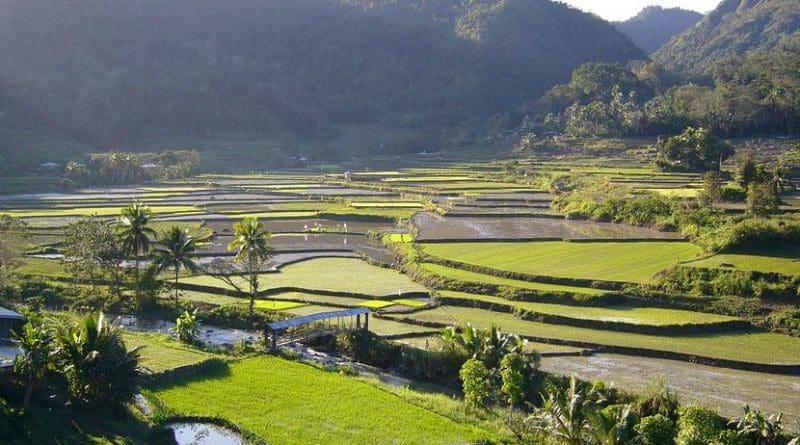Shrew Rats Can Control Earthworms Destroying Cordi’s Rice Terraces – OpEd
Three rat species, found friendly to rice crops ,were discovered by a group of scientists from the Philippine Rice Institute (PhilRice) as effective control measures against giant earthworms destroying many rice terraces in the Cordillera region of the Phtlippines, partcularly the famed Banaue Rice Terraces
One of the rats, the lowland striped shrew rat (S. Chrotomys mindorensis) is believed the nemesis of the giant earthworm that has long been a problem and has even threatened to wash out one of the world’s agriculture landmarks.
The other “friendly” rodent species is the common Philippine forest rat (S. Rattus everetti). As for the other friendly farm rat, the scientists are still doing further taxonomic research to know to which species it belongs.
In an article “The Mysterious Rats of the Banaue Rice Terraces” released recently by PhilRice, it was learned that not all rats are harmful to farm crops, particularly those planted in the Banaue area. The article is part of the mother paper “Rodents and Other Small Mammals in Banaue and Hungduan Rice Terraces, Philippines” by Dr. Ravindra Joshi and other scientists from PhilRice, Australia and local counterparts from Ifugao local government.
The researchers led by Joshi, include Alexander Stuart, a graduate student on wildlife management and conservation from Reading University in the United Kingdom; and Rachel Miller, Youth Ambassador for Development of Australia.
Joshi had been doing research on ecosystem preservation and pest management of the terraces. The most popular of his works was the Banaue rice earthworms.
Stuart, had previous involvements in forest farm ecosystems, including his participation in the project on mammal counts, reception work, mapping of burnt lands, culling and patrolling at the Mkuze Game Reserve, South Africa, besides another project, in connection with his Reading University graduate works, in Gibbon Rehabilitation Center, Thailand .
The team is now trying to determine the habitat distribution of the rat species in Banaue and Hungduan to establish a baseline data that might be useful in evaluating changes in the unique status of the rice terraces’ ecosystem.
What prompted the rodent research was the recorded traditional rat-pest problem in the terraces. In an earlier study, Banaue and Hungduan farmers ranked rodents as first among the three most pre-harvest pests of their rice crops, besides the damages this pest had inflicted on local warehouses and households.
The study on a survey of rat species and their behaviors was followed by introducing trapping techniques in farm areas and residential communities, which yielded to capturing six rat species.
The early significant findings in the study included the food preferences of the rats. Stuart had initially found that the lowlands striped shrew rat feeds on insects, snails and the giant earthworms. The common Philippine forest rat eats fruits and wild plants.
Miller started studying the reproductive biology of the pest rats, and to find means to protect or separate the newly discovered friendly rats from the former.
One possible measure is controlling the pest rats without using pesticides. She said: It is important to find out [and understand] the habitat of the ‘good rats’ [Chrotomys mindorensis] to protect them when the control method is applied.
The researchers were glad they did not find the most notorious rat species, Rattus argentiventer, in the area. It is known as the major rodent pest in the rice-growing systems of mainland Southeast Asia and Indonesian archipelago. This rat species has been noted thriving in Laguna. Mindanao, Mindoro and Negros islands.
“Many believe that some of the good rats are also present in the lowlands, which we doubt, because they are mostly found, according to this study, in farmlands near forest areas,” Miller said.
Joshi said this might be because of the unique biodiversity environment on the rice terraces that play hosts to abundant native mammal fauna, with “native species effectively holding back the competitively inferior invaders,” apparently referring to the more destructive Rattus argentiventer.
“This is good indication that the rice terraces environment despite its very long history of human activities and interventions, nevertheless remains a relatively healthy one. This finding provides an important benchmark to which future developments can be composed [with],” Josh said.
Earthworms have been blamed as the culprits by Ifugao farmers for the collapse of the rice terraces.
Residents and local farmers in Ifugao believe that earthworms are alien species, intentionally introduced after the 1990s and are therefore the sole reason for the deterioration of the Ifugao Rice Terraces.
The earthworms are either be hermaphroditic, meaning they can reproduce asexually or sexually, where two individuals copulate and produce fertilized eggs enclosed in a cocoon. The giant earthworms are pigmented, local to the rice terraces and thrive in moist soil that are not water-logged. The other kind of earthworm, Pontoscolex, are unpigmented, introduced species, and can live in both dry and water-logged rice paddies.
The earthworms have inhabited Ifugao long before 1990s, but not in the terraces but rather in the muyong — the communal forests within the vicinity of the rice terraces. Because of the deteriorating forests of Ifugao, earthworms found sanctuary in the rice terraces to survive.
Unlike golden kuhol, earthworms are native to the area, and are not introduced from foreign places. In addition, Ifugao farmers’ shift from traditional to modern farming is another cause of earthworm infestation in the rice paddies, including the use of pesticides since these decimate the predators of the earthworms.
Other triggers to the collapse of the rice terraces are environmental factors like earthquakes that alter irrigation lines, and climate changes like El Nino and La Nina.

